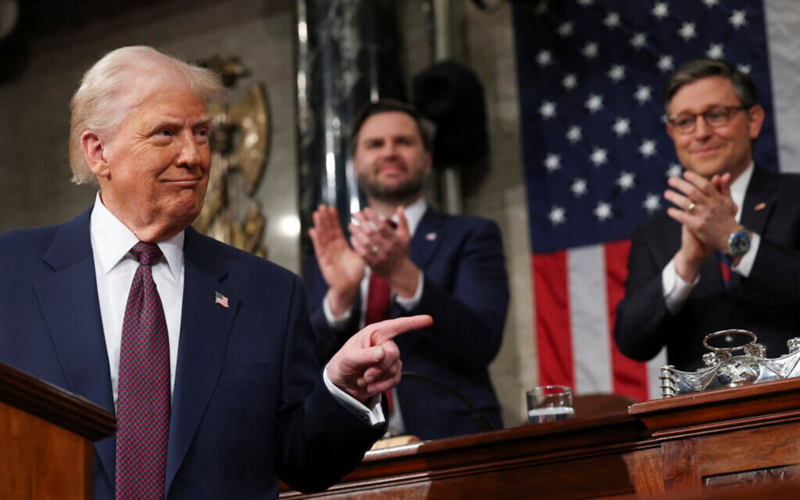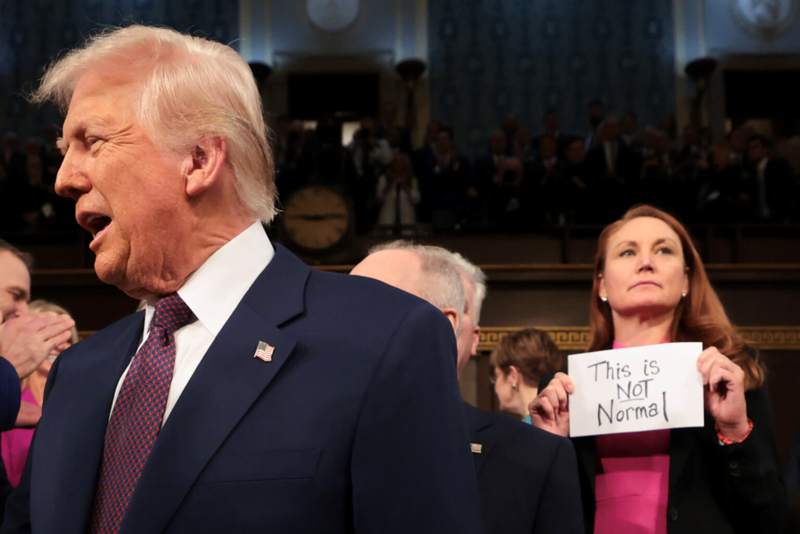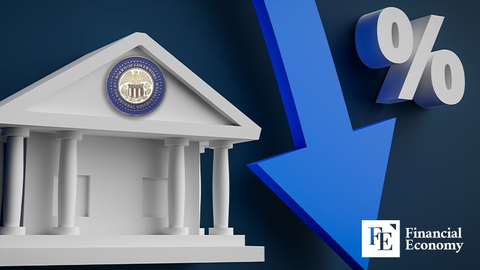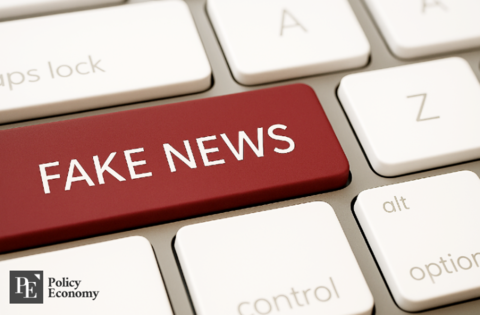Trump Declares “America is Back”: A Bold Vision or a Nation Further Divided?
Input
Modified
Trump’s Economic Agenda: Protectionism, Tax Cuts, and Immigration Crackdowns Foreign Policy Takes a Backseat: Prioritizing ‘America First’ Over Global Affairs Partisan Showdown: Reactions to Trump’s Speech and America’s Deep Divisions

Trump’s Economic Agenda: Protectionism, Tax Cuts, and Immigration Crackdowns
Trump Declares 'America is Back' in Defiant Congress Address, Sparks Fierce Partisan Showdown. With Bold Promises and Fiery Rhetoric, Trump Unveils His Vision for America—But Can He Unite a Divided Nation?
The highly anticipated address to Congress by President Donald Trump on March 4, 2025, was nothing short of a political spectacle, further solidifying his trademark defiance, dedication to conservative policies, and the severe divisions that define American politics. His speech, which lasted an unprecedented 99 minutes, was indicative of a leader who was emboldened by his return to the White House. He declared, "America is back" and advocated for an aggressive legislative agenda. Nevertheless, his address also illustrated the profound divisions in Washington, as Democratic legislators demonstrated in a variety of ways, underscoring the heightened polarization that has only intensified during his tenure.
A Broad Perspective: The Economic Future of America and Trump's Domestic Agenda
The address of Donald Trump was replete with ambitious policy proposals and audacious proclamations, many of which were intended to contradict or undermine the initiatives of the previous Biden administration. His speech established the foundation for a series of domestic policy initiatives, such as the "Golden Dome," a proposed missile defense system, border security enhancements, and tax cuts. His rhetoric was unequivocal: America would reestablish its global prominence by implementing economic protectionism, stringent immigration regulations, and a robust military.
A continuation of his signature tariff policies was one of the main components of Trump's economic plan. Despite the apparent economic turmoil that these protectionist measures have caused, he defended the imposition of hefty tariffs on imports from Canada, Mexico, and China. Critics cautioned that an escalating trade war could exacerbate market volatility and disrupt supply chains, despite the fact that his supporters praised the action as a necessary measure to protect American industries and employment. Donald Trump, on the other hand, dismissed these concerns, asserting that his strategy would ultimately restore economic stability and increase American prosperity.
His speech devoted a substantial amount of time to inflation, a problem that has persisted in the lives of American households. Former President Joe Biden was directly faulted by the President for the precipitous price increases, particularly in fundamental commodities like eggs. Nevertheless, despite his propensity to assign blame, Trump failed to provide any tangible solutions to the increasing cost of living. Nevertheless, his primary objective was to stimulate the economy by reducing government regulations, lowering taxes, and increasing energy production.
Trump's signature hardline position on immigration was also prominently featured in the speech. Republican lawmakers responded with thunderous applause to his appeal for Congress to enact a comprehensive border security measure. Citing executive orders that have already tightened immigration enforcement, Trump portrayed his administration as taking unprecedented action in securing the southern border. His emphasis on border security was a direct challenge to the more lenient policies of the Biden era, framing his approach as a necessary measure to safeguard American sovereignty and safety.

Foreign Policy Takes a Backseat: Prioritizing ‘America First’ Over Global Affairs
Although Trump's speech was predominantly focused on domestic matters, he did briefly address international issues. His disclosure of a letter from Ukrainian President Volodymyr Zelenskyy, which indicated Ukraine's readiness to execute a critical minerals deal, was one of the most notable mentions. This occurred immediately following Trump's contentious meeting with Zelenskyy, which prompted inquiries regarding the administration's approach to future U.S.-Ukraine relations. The policies of the Trump administration regarding the conflict with Russia continue to be a contentious issue, as a result of his historical skepticism regarding U.S. support for Ukraine.
Trump announced the capture of Mohammad Sharifullah, the individual he identified as the mastermind behind the deadly 2021 bombing that took place during the tumultuous U.S. withdrawal from Afghanistan, in a moment that emphasized his tough-on-terror rhetoric. The President characterized this as a substantial victory for national security, thereby reaffirming his administration's dedication to the implementation of aggressive counterterrorism measures.
Nevertheless, Trump largely refrained from engaging in more in-depth discussions of foreign policy beyond these brief references, indicating a steadfast commitment to prioritizing domestic "America First" objectives. His speech did not contain any significant references to the Israel-Palestine conflict, China's increasing influence, or NATO—issues that are fundamental to the current state of global geopolitics. This omission served to reinforce the notion that Trump's presidency is primarily inward-looking, favoring nationalistic policies over international alliances.

Partisan Showdown: Reactions to Trump’s Speech and America’s Deep Divisions
Trump's speech was intended to serve as a testament to the strength and unity that his supporters possess; however, it also served as an illustration of the profound divisions that exist within American politics. The Democratic legislators' response served as a reminder of the ongoing controversy surrounding Trump's leadership. Several Democratic members of Congress participated in visible protests during his speech, including donning pink attire, holding up signs with messages such as "False" and "Musk steals," and even walking out in defiance. One of the most dramatic moments occurred when Texas Representative Al Green was escorted out after vocally confronting the President's legitimacy.
These protests were promptly condemned by the White House. The Democratic legislators' actions were deemed "shameful" by Press Secretary Karoline Leavitt, who accused them of disrespecting both the President and the American public. She cited post-speech polling from CNN and CBS News/YouGov, which suggested that the address was well-received by a substantial number of viewers, particularly among Trump's supporters. These reactions served to reconfirm the deeply entrenched partisan divisions that have characterized American politics since Trump's inaugural election in 2016.
The speech was perceived by Trump's supporters as a reaffirmation of his dedication to his campaign promises and a confident, unapologetic vision for the future of America. Many of them commended his emphasis on domestic policy, particularly his advocacy for border security and tax reductions, which they contend will result in a more prosperous nation. In contrast, the address was criticized by critics as yet another instance of combative politics, characterized by the absence of substantive solutions and the presence of grievances.
The nation's political divide was also reflected in the public response beyond Washington. The speech was portrayed as a forceful statement of leadership by conservative media outlets, while liberal commentators criticized it as divisive and misleading. Contrasting perspectives emerged on social media, as Trump supporters celebrated his return to form and his detractors cautioned that his policies would only serve to further polarize the nation.
Trump's address to Congress was a representation of his presidency—it was audacious, unapologetic, and profoundly divisive. His vision for the United States is centered on the rejection of globalist ideals, the implementation of strict immigration enforcement, and the implementation of aggressive economic policies. His supporters regard his leadership as a necessary corrective measure following the Biden years, while his critics are concerned that his approach will further exacerbate societal divisions and alienate international allies.
The Future of Trump's America
The efficacy of his policies will be evaluated as his administration advances. Will his tax cuts and tariffs serve as the promised economic stimulus, or will they exacerbate financial instability? Will his strict immigration policies enhance security or exacerbate humanitarian concerns? And, most importantly, will his leadership unite Americans, or will the profound divisions in Washington and beyond deepen?
Trump's ambitious agenda will either solidify his legacy as a transformative leader or further entrench the political discord that has come to define modern American governance. Only time will tell. The impact of Trump on the country remains as profound and controversial as ever, regardless of the outcome.




















